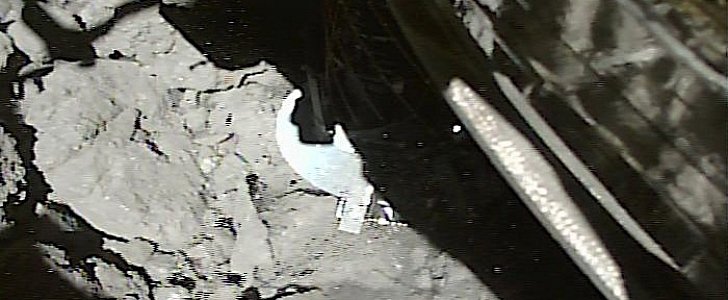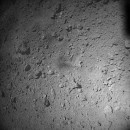All across the solar system, human-made machines are hard at work exploring the wonders of space more than before. Presently, we have tool beyond the heliosphere, on the Moon and Mars, and even on asteroids.
In September last year, a Japanese machine landed on an asteroid called Ryugu, thousands of miles away from Earth. At that time, the achievement was a premiere for space exploration.
On July 11, 2019, the machine, called Hayabusa2, did it again in the second run meant to collect another sample from the space rock. And, just like the first time, it sent back photos.
The images released by the Japanese Space Agency (JAXA) were taken by one the spacecraft’s cameras and show the surface of the asteroid 4 seconds before touchdown, at the touchdown itself and 4 seconds after.
This is the first time such clear images show the surface of an asteroid. As soon as the photos were taken, the spacecraft departed the asteroid.
“We have confirmed that the spacecraft performed the planned ΔV to return to the home position. Hayabusa2 will reach the home position around 10:30 JST tomorrow,” JAXA said in a Twitter post.
The Hayabusa2 mission is designed to collect and return asteroid samples back to Earth. For sample collection purposes two cylinder-shaped rovers are used. They hop around on the asteroid, changing their position on the surface of the asteroid and survey other locations.
Hayabusa also conducted a brand new experiment earlier this year. In April, a slug called Small Carry-on Impactor (SCI), was released from the Hayabusa2 spacecraft and hit the surface at a speed of 2 km per second (4,473 mph).
The goal was to see whether the resulting impact would reveal the subsurface materials that are to be brought back to Earth for analysis.
Hayabusa2 was launched in December 2014. In December this year it will fire up its engines for a scheduled return to the home planet one year later.
On July 11, 2019, the machine, called Hayabusa2, did it again in the second run meant to collect another sample from the space rock. And, just like the first time, it sent back photos.
The images released by the Japanese Space Agency (JAXA) were taken by one the spacecraft’s cameras and show the surface of the asteroid 4 seconds before touchdown, at the touchdown itself and 4 seconds after.
This is the first time such clear images show the surface of an asteroid. As soon as the photos were taken, the spacecraft departed the asteroid.
“We have confirmed that the spacecraft performed the planned ΔV to return to the home position. Hayabusa2 will reach the home position around 10:30 JST tomorrow,” JAXA said in a Twitter post.
The Hayabusa2 mission is designed to collect and return asteroid samples back to Earth. For sample collection purposes two cylinder-shaped rovers are used. They hop around on the asteroid, changing their position on the surface of the asteroid and survey other locations.
Hayabusa also conducted a brand new experiment earlier this year. In April, a slug called Small Carry-on Impactor (SCI), was released from the Hayabusa2 spacecraft and hit the surface at a speed of 2 km per second (4,473 mph).
The goal was to see whether the resulting impact would reveal the subsurface materials that are to be brought back to Earth for analysis.
Hayabusa2 was launched in December 2014. In December this year it will fire up its engines for a scheduled return to the home planet one year later.
[PPTD] These images were taken before and after touchdown by the small monitor camera (CAM-H). The first is 4 seconds before touchdown, the second is at touchdown itself and the third is 4 seconds after touchdown. In the third image, you can see the amount of rocks that rise. pic.twitter.com/ssZU5TV3x9
— HAYABUSA2@JAXA (@haya2e_jaxa) 11 iulie 2019






